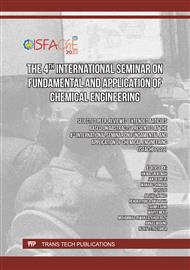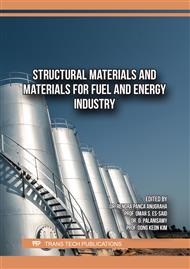[1]
Y. Li and J. Lu, "Metal-Air Batteries: Will They Be the Future Electrochemical Energy Storage Device of Choice?," ACS Energy Lett, vol. 2, no. 6, p.1370–1377, 2017.
DOI: 10.1021/acsenergylett.7b00119
Google Scholar
[2]
H. Kobashi, M. Oshitani, and G. S. Y. Corporation, "Seawater Activated Batteries : Magnesium," Magnesium, p.156–164, 2009.
DOI: 10.1016/b978-044452745-5.00123-4
Google Scholar
[3]
K. Kakaei, M. D. Esrafili, and A. Ehsani, "Oxygen Reduction Reaction," Interface Science and Technology, vol. 27, p.203–252, 2019.
DOI: 10.1016/B978-0-12-814523-4.00006-X
Google Scholar
[4]
M. Fauziyah, W. Widiyastuti, and H. Setyawan, "Nitrogen-Doped Carbon Aerogels Prepared by Direct Pyrolysis of Cellulose Aerogels Derived from Coir Fibers Using an Ammonia-Urea System and Their Electrocatalytic Performance toward the Oxygen Reduction Reaction," Ind Eng Chem Res, vol. 59, no. 49, 2020.
DOI: 10.1021/acs.iecr.0c03771
Google Scholar
[5]
G. Lin, R. Ma, Y. Zhou, Q. Liu, X. Dong, and J. Wang, "KOH activation of biomass-derived nitrogen-doped carbons for supercapacitor and electrocatalytic oxygen reduction," Electrochim Acta, vol. 261, p.49–57, 2018.
DOI: 10.1016/j.electacta.2017.12.107
Google Scholar
[6]
A. N. Malkova, N. A. Sipyagina, I. O. Gozhikova, Y. A. Dobrovolsky, D. V. Konev, A. E. Baranchikov, O. S. Ivanova, A. E. Ukshe, and S. A. Lermontov, "Electrochemical properties of carbon aerogel electrodes: Dependence on synthesis temperature," Molecules, vol. 24, no. 21, p.1–13, 2019.
DOI: 10.3390/molecules24213847
Google Scholar
[7]
S. Zhuang, E. S. Lee, L. Lei, B. B. Nunna, L. Kuang, and W. Zhang, "Synthesis of nitrogen-doped graphene catalyst by high-energy wet ball milling for electrochemical systems," Int J Energy Res, vol. 40, no. 15, p.2136–2149, 2016.
DOI: 10.1002/er.3595
Google Scholar
[8]
Q. Lv, W. Si, J. He, L. Sun, C. Zhang, N. Wang, Z. Yang, X. Li, X. Wang, W. Deng, Y. Long, C. Huang, and Y. Li, "Selectively nitrogen-doped carbon materials as superior metal-free catalysts for oxygen reduction," Nat Commun, vol. 9, no. 1, 2018.
DOI: 10.1038/s41467-018-05878-y
Google Scholar
[9]
H. W. Liang, X. Zhuang, S. Brüller, X. Feng, and K. Müllen, "Hierarchically porous carbons with optimized nitrogen doping as highly active electrocatalysts for oxygen reduction," Nat Commun, vol. 5, no. May, p.1–7, 2014.
DOI: 10.1038/ncomms5973
Google Scholar
[10]
D. Guo, R. Shibuya, T. Kondo, and J. Nakamura, "Active sites in nitrogen-doped carbon materials for oxygen reduction reaction," Carbon-Based Metal-Free Catalysts: Design and Applications, vol. 1–2, no. 6271, p.227–249, 2018.
DOI: 10.1002/9783527811458.vol1-ch8
Google Scholar
[11]
S. Wang, X. Peng, L. Zhong, J. Tan, S. Jing, X. Cao, W. Chen, C. Liua, and R. Sun, "An ultralight, elastic, cost-effective, and highly recyclable superabsorbent from microfibrillated cellulose fibers for oil spillage cleanup," J Mater Chem A Mater, vol. 3, no. 16, p.8772–8781, 2015.
DOI: 10.1039/C4TA07057G
Google Scholar
[12]
M. Mahmoudpour, J. E. N. Dolatabadi, M. Hasanzadeh, and J. Soleymani, "Carbon-based aerogels for biomedical sensing: Advances toward designing the ideal sensor," Adv Colloid Interface Sci, vol. 298, p.102550, 2021.
DOI: 10.1016/j.cis.2021.102550
Google Scholar
[13]
A. D. French, "Idealized powder diffraction patterns for cellulose polymorphs," p.885–896, 2014.
DOI: 10.1007/s10570-013-0030-4
Google Scholar
[14]
B. M. Jović, T. Dobrovolska, U. Lačnjevac, I. Krastev, and V. D. Jović, "Characterization of electrodeposited Cd-Co alloy coatings by anodic linear sweep voltammetry," Electrochim Acta, vol. 54, no. 28, p.7565–7572, 2009.
DOI: 10.1016/j.electacta.2009.08.025
Google Scholar
[15]
S. L. J. Gojković, S. K. Zečević, M. D. Obradović, and D. M. Dražić, "Oxygen reduction on a duplex stainless steel," Corros Sci, vol. 40, no. 6, p.849–860, 1998.
DOI: 10.1016/S0010-938X(98)00004-3
Google Scholar
[16]
A. J. van Stroe and L. J. J. Janssen, "Determination of the diffusion coefficient of oxygen in sodium chloride solutions with a transient pulse technique," Anal Chim Acta, vol. 279, no. 2, p.213–219, 1993.
DOI: 10.1016/0003-2670(93)80320-K
Google Scholar
[17]
M. H. Shao, P. Liu, and R. R. Adzic, "Superoxide anion is the intermediate in the oxygen reduction reaction on platinum electrodes," J Am Chem Soc, vol. 128, no. 23, p.7408–7409, 2006.
DOI: 10.1021/ja061246s
Google Scholar
[18]
H. W. Kim, V. J. Bukas, H. Park, S. Park, K. M. Diederichsen, J. Lim, Y. H. Cho, J. Kim, W. Kim, T. H. Han, J. Voss, A. C. Luntz, and B. D. McCloskey, "Mechanisms of two-electron and four-electron electrochemical oxygen reduction reactions at nitrogen-doped reduced graphene oxide," ACS Catal, vol. 10, no. 1, p.852–863, 2020.
DOI: 10.1021/acscatal.9b04106
Google Scholar



